Who Will Win the Tony for Best Design for a Broadway Musical?
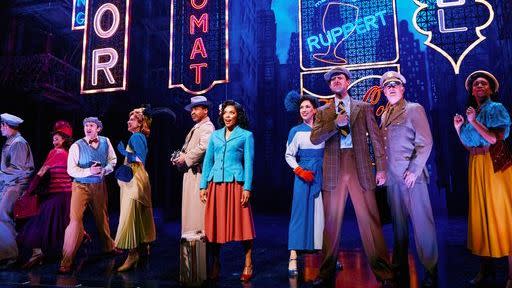
When Ariana DeBose hosts the 76th Annual Tony Awards this Sunday, the ceremony will be one of the most vibrant—and hotly contested—theater contests since the before times. Broadway is back, baby, and at the Tonys, stars of the stage—along with directors, choreographers, and more—compete for theater’s top honors. For design buffs, though, it’s often the set that steals the limelight—especially when it comes to musicals, where the stagings are as spectacular as they are inventive.
This year, the nominees for best scenic design for a musical run the gamut, from a Florida farm town where the jokes are as corny as the setting to a Gotham tribute to a helluva town. Here, we give you a closer look at what’s on stage—and at stake—for the five nominees for best musical scenic productions.
Shucked
Scenic design by Scott Pask

This year, designer Scott Pask has two nominations in this category—Shucked and Some Like It Hot. The “farm-to-fable” Shucked at the Nederlander Theater is one of the corniest musicals ever to appear on the Great White Way, both for the caliber of its jokes about the mythical Cobb County (trust us, they’re corny) and for the literal corn that is the focus of the story and that frames Pask’s set. There are some 270 cornstalks on stage, some hand-painted on canvas, and about 100 that seem almost alive. “They’re the corn puppets,” Pask says. “There is a complex system of automation that allows the corn to move with the music.”
The centerpiece of Pask’s set is a barn with two silos, all set on a six-degree angle. “It made sense to play with the architecture,” he says. “The wonkiness is in keeping with the off-kilter humor of the show.”
Some Like It Hot
Scenic design by Scott Pask
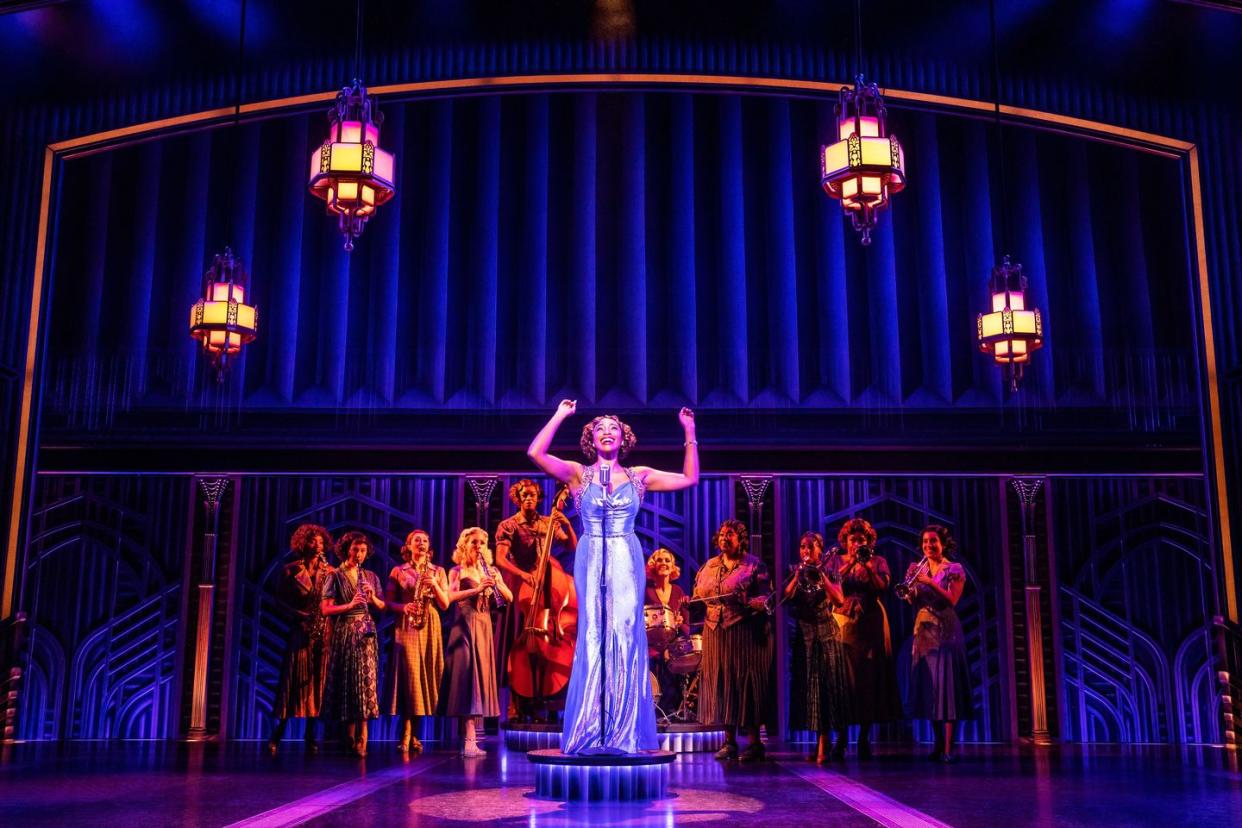
Pask’s other nod for best scenic design is one of 13 Tony nominations for Some Like It Hot, the most garnered by any musical this year. The Shubert Theater production is based on the 1959 film musical of the same name. It is set in 1933 and follows a pair of Chicago jazz musicians who witness a mob hit and disguise themselves by joining an all-female band as they escape to California. The ever-changing sets morph from a Chicago speakeasy to a full-size train to the breezy backdrop of the Hotel del Coronado in California.
“The starting point was the end of Prohibition,” Pask explains. “We looked at Art Deco, which had become a massive influence at the time. And the set has to be transformable, shifting nimbly and quickly as the actors go in and out of character and costume. We go from the literal underbelly of Chicago to the glittering sun and sea of the West Coast, with a color palette of soft jewel tones. It’s like going from darkness into light, and that journey is made visually as well as geographically on stage.”
New York, New York
Scenic design by Beowulf Boritt
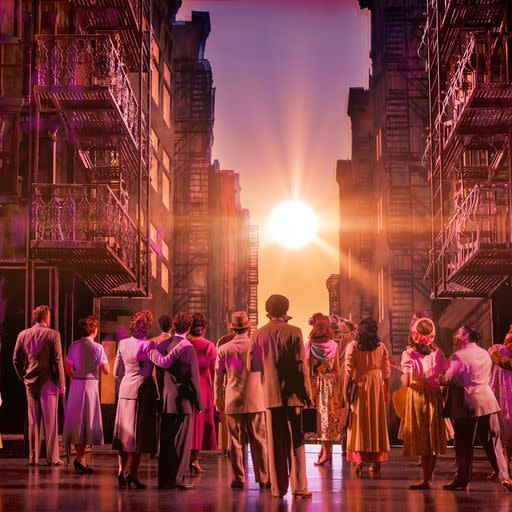
It isn’t easy to recreate the vitality of a city like New York—especially when Times Square is on a theater’s doorstep. But Beowulf Boritt’s Tony-nominated set for New York, New York more than holds its own in this love letter to the city, vibrantly choreographed by Susan Stroman.
Boritt’s set design incorporates the neon signs of Times Square, Manhattan-henge, and a Times Square newsstand where all the papers are dated June 20, 1946—the day after Joe Lewis beat Billy Conn in an iconic boxing match. In another scene, a group of doormen push white snowdrifts across the stage, then raise their shovels in the air to simulate the shape of Central Park’s Bow Bridge.
The set, the designer told Broadway.com, is “ultimately not about the architecture, it’s about people. How all these different people come into this crazy place, and we all live on top of each other. That kind of ferment creates the genius and amazingness that is New York City.”
Sweeney Todd: The Demon Barber of Fleet Street
Scenic design by Mimi Lien
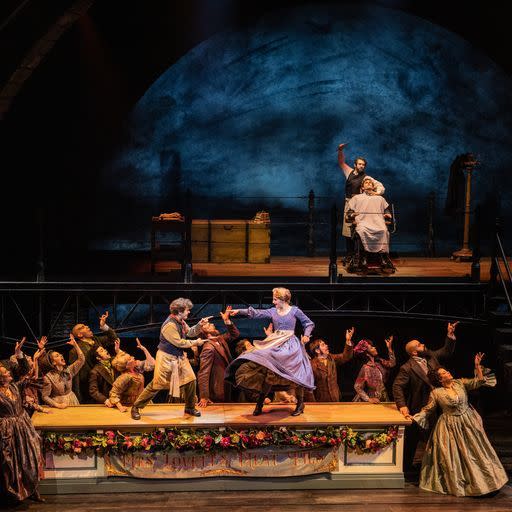
Stephen Sondheim and Hugh Wheeler’s classic, Sweeney Todd, was first staged on Broadway in 1970. The version now at the Lunt-Fontanne Theatre is directed by Hamilton’s Thomas Kail and stars Josh Groban as the crazed London barber out for revenge. Designer Mimi Lien, who studied architecture in college and won a MacArthur “genius” award for her theater, opera, and dance sets, evoked the grit and gloom of Industrial Revolution–era London with a bi-level set consisting of a cast-iron London bridge connected to a tower and a working crane.
As the story sways from the comedic to the macabre, Lien’s set delivers eye-popping backdrops that deliver both the drama and the joke. Mrs. Lovett’s failing pie shop is a wooden counter with a hand-lettered sign and multiple layers of grime. Meanwhile, Sweeney Todd’s barber chair is connected to a chute that whisks his victims to a cellar where a roaring oven turns them into fresh meat for Mrs. Lovett’s pies. Lien’s rotating set goes full Dickensian, creaking and cranking to convey Sweeney’s description of London as a “hole in the world like a great black pit.”
Lerner & Loewe’s Camelot
Scenic design by Michael Yeargan & Ben Pearcy/59 Productions
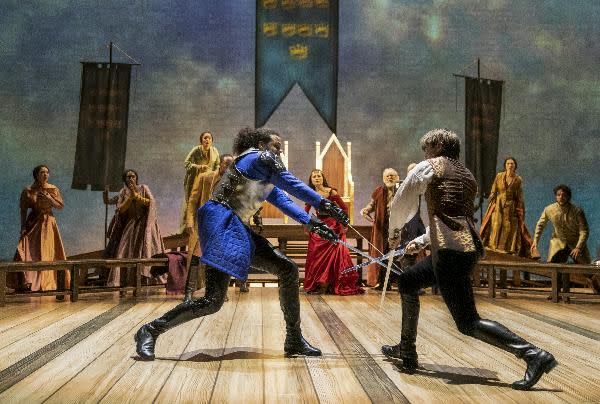
In this Lincoln Center Theater production of the 1960 classic (Learner and Loewe’s follow-up to My Fair Lady), with a new book by Aaron Sorkin and direction by Bartlett Sher, production designer Michael Yeargan and projection designer Ben Pearcy were tapped to recreate the legendary Arthurian royal realm.
As Yeargan and Pearcy explain in this video, the set at the Vivian Beaumont Theater consists of what appears to be a raked wooden floor (it’s actually painted to look like wood) connected by bridges to massive stone arches that hover over the orchestra. The effect allows the audience to glimpse the orchestra’s musicians and to feel closer to the action. Meanwhile, Pearcy’s beautiful projections conjure everything from a medieval castle to creeping vines in a spooky forest inhabited by the fairy enchantress Morgan le Fay.
You Might Also Like
